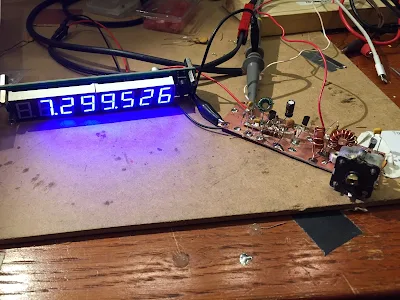 |
| NAA Towers -- Arlington Va. 1913 |
Brad WA8WDQ wrote to us about a VLF (24 kHz) his receiver project (see below). This led to some Googling about the VLF station NAA. Wow, there is some important radio history associated with that call sign. The station's original location was just a few miles from I where I live now. From Wikipedia (https://en.wikipedia.org/wiki/VLF_Transmitter_Cutler):
The station began operations in 1913 as a radio telegraphy station call sign NAA in Arlington, Virginia, at a facility next to Fort Myer. Although its broadcasts occasionally included band concerts and speeches, it was most famous for its nightly time signals. The three towers known then as "The Three Sisters" stood 600 feet, 450 feet and 200 feet (183, 137, and 61 m) above the ground. The site was referred to as "Radio", Virginia. The towers were the second largest man-made structure in the world behind only the Eiffel Tower. The word "Radio" was first used instead of "Wireless," in the name of this Naval Communications facility. The First Trans-Atlantic voice communication was made between this station and the Eiffel Tower in 1915. The Nation set its clocks by the signal and listened for its broadcast weather reports. The Towers were dismantled in 1941 as a menace to aircraft approaching the new Washington National Airport. The towers stand today at United States Naval Academy in Maryland, on the edge of the Chesapeake Bay.
Be sure to read about the de-icing system for the antenna. It uses more power than the actual transmitter!
From Brad:
Bill, Pete,
Here's the current status of the 24 KHz NAA SID receiver. All the major sub-assemblies are mounted in the chassis and power is hooked up. For convenience, I've been using the PowerWerx USBbuddy switching DC-DC converter to supply +5V power to the Raspberry Pi from the +12V input. I've found them extremely RF quiet, clean and stable; capable of supplying 3A though this project will only need about 1.5A @ +5V. At this point, I'm just waiting for Adafruit to send the A/D chip I'll wire up to the Pi on that empty protoboard just under the meter. Speaking of the meter, it's not really needed as the Pi records and broadcasts over Wi-Fi the received signal level. However, I like my projects to have some sort of physical human interface so I added the signal level meter and an LED for SID event alarms :).
As previously mentioned, my bench test of the receiver using my signal generator was successful. Once everything is wired, I'll do an actual on-air signal test receiving NAA.
Brad WA8WDQ



































